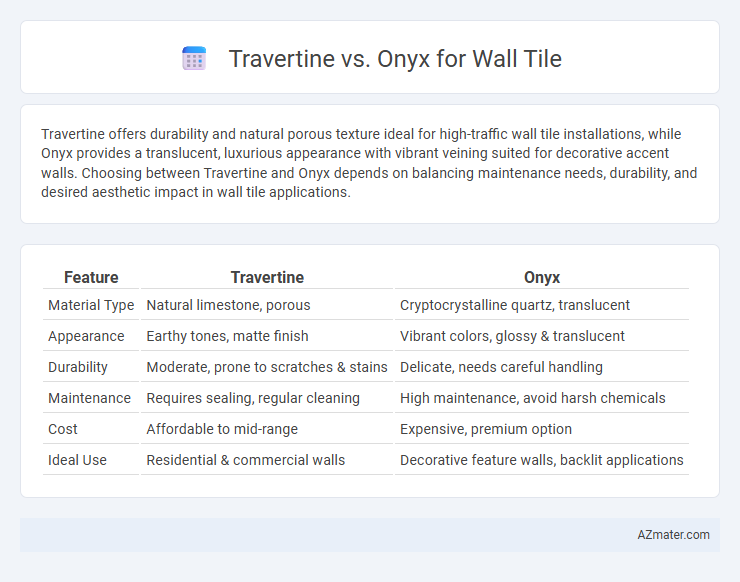Travertine offers durability and natural porous texture ideal for high-traffic wall tile installations, while Onyx provides a translucent, luxurious appearance with vibrant veining suited for decorative accent walls. Choosing between Travertine and Onyx depends on balancing maintenance needs, durability, and desired aesthetic impact in wall tile applications.
Table of Comparison
| Feature | Travertine | Onyx |
|---|---|---|
| Material Type | Natural limestone, porous | Cryptocrystalline quartz, translucent |
| Appearance | Earthy tones, matte finish | Vibrant colors, glossy & translucent |
| Durability | Moderate, prone to scratches & stains | Delicate, needs careful handling |
| Maintenance | Requires sealing, regular cleaning | High maintenance, avoid harsh chemicals |
| Cost | Affordable to mid-range | Expensive, premium option |
| Ideal Use | Residential & commercial walls | Decorative feature walls, backlit applications |
Introduction to Travertine and Onyx Wall Tiles
Travertine wall tiles, formed from natural limestone deposits, offer a durable and porous surface with unique, earthy tones and veining that enhance interior aesthetics. Onyx wall tiles, made from crystallized limestone, are prized for their translucent qualities and vibrant patterns, creating striking visual effects with natural backlighting. Both materials provide distinct textural and color variations, making them popular choices for luxury wall installations.
Key Differences Between Travertine and Onyx
Travertine wall tiles offer a porous, matte surface with natural pits and veins, providing a classic, earthy aesthetic ideal for rustic or traditional interiors. Onyx tiles, in contrast, feature a translucent, glossy finish with dramatic veining and vibrant colors, creating a luxurious and striking visual impact. Key differences include durability--travertine is more resistant to etching and scratching, while onyx requires careful maintenance due to its softness and susceptibility to damage.
Aesthetic Appeal: Travertine vs Onyx
Travertine offers a warm, earthy aesthetic with natural pitted textures and subtle color variations, ideal for creating a rustic or classic look in wall tile applications. Onyx stands out with its translucent, vibrant patterns and rich veining, providing a luxurious and dramatic visual impact when backlit or used in feature walls. The choice between travertine and onyx largely depends on desired ambiance: travertine emphasizes natural elegance and durability, while onyx highlights exquisite beauty and sophistication.
Durability and Longevity Comparison
Travertine offers exceptional durability with a hardness rating of 4 to 5 on the Mohs scale, making it resistant to scratches and suitable for high-traffic wall installations. Onyx, though visually striking with its translucent qualities, ranks lower in durability, requiring careful maintenance to prevent surface etching and damage over time. Longevity of travertine wall tiles surpasses that of onyx, as travertine withstands moisture and physical impact better, ensuring a longer-lasting wall finish.
Application Suitability: Where to Use Each Material
Travertine wall tiles excel in high-traffic areas such as living rooms, bathrooms, and kitchens due to their durability and natural slip resistance. Onyx, with its translucent and luxurious appearance, is best suited for decorative applications like feature walls, backsplashes, and low-traffic spaces where its delicate nature can be preserved. Both materials offer unique aesthetic qualities, but choosing travertine ensures practical longevity, while onyx provides a striking visual focal point.
Maintenance and Care Requirements
Travertine wall tiles require regular sealing to prevent staining and moisture absorption due to their porous nature, while onyx tiles demand delicate handling because of their softer surface and susceptibility to scratching. Cleaning travertine involves pH-neutral cleaners to avoid etching, whereas onyx needs gentle, non-abrasive products to maintain its translucent appearance. Both materials benefit from routine dusting and immediate spill cleanup to preserve their natural beauty and longevity.
Cost Analysis: Travertine vs Onyx
Travertine wall tiles typically cost between $3 and $7 per square foot, making them a more budget-friendly option compared to onyx, which ranges from $15 to $30 per square foot due to its rarity and luxurious appeal. Installation expenses for onyx are higher, averaging $20 to $40 per square foot, because of its fragility and need for specialized handling, whereas travertine installation usually falls between $10 and $20 per square foot. Maintenance costs for onyx are also elevated, requiring regular sealing and careful cleaning to preserve its translucent quality, while travertine demands less intensive upkeep, contributing to lower overall long-term expenses.
Installation Tips and Challenges
Travertine wall tile requires sealing before and after installation to prevent moisture absorption and staining, with careful cutting to avoid chipping due to its porous nature. Onyx, being softer and more fragile, demands precise handling and specialized adhesives to prevent cracking during installation, along with backlighting considerations to enhance its translucent beauty. Both materials need a skilled installer familiar with natural stone characteristics to ensure durability and aesthetic appeal.
Environmental Impact and Sustainability
Travertine wall tiles, sourced from natural limestone, have a lower environmental impact due to their abundant availability and minimal chemical processing compared to onyx. Onyx tiles, formed from rare mineral deposits, typically require more intensive quarrying and transportation, contributing to a higher carbon footprint. Choosing travertine supports sustainability efforts through its durability and recyclability, while onyx's limited sources and fragile nature pose challenges for long-term eco-friendly use.
Which Wall Tile Is Best for Your Space?
Travertine wall tiles offer timeless durability and a natural, rustic look with porous texture ideal for high-traffic areas needing slip resistance, while Onyx provides a luxurious, translucent appearance with vibrant colors perfect for accent walls in low-moisture spaces. Consider travertine for kitchens, bathrooms, or entryways due to its strength and ease of maintenance, whereas onyx suits decorative settings like living rooms or hotel lobbies where its striking veining and light-reflective quality can be showcased. Choosing the best tile depends on balancing durability, aesthetic preference, and the specific environmental demands of your space.

Infographic: Travertine vs Onyx for Wall Tile
 azmater.com
azmater.com